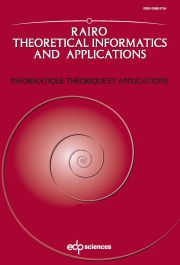Article contents
Closure properties of hyper-minimized automata
Published online by Cambridge University Press: 14 November 2011
Abstract
Two deterministic finite automata are almost equivalent if they disagree in acceptance only for finitely many inputs. An automaton A is hyper-minimized if no automaton with fewer states is almost equivalent to A. A regular language L is canonical if the minimal automaton accepting L is hyper-minimized. The asymptotic state complexity s∗(L) of a regular language L is the number of states of a hyper-minimized automaton for a language finitely different from L. In this paper we show that: (1) the class of canonical regular languages is not closed under: intersection, union, concatenation, Kleene closure, difference, symmetric difference, reversal, homomorphism, and inverse homomorphism; (2) for any regular languages L1 and L2 the asymptotic state complexity of their sum L1 ∪ L2, intersection L1 ∩ L2, difference L1 − L2, and symmetric difference L1 ⊕ L2 can be bounded by s∗(L1)·s∗(L2). This bound is tight in binary case and in unary case can be met in infinitely many cases. (3) For any regular language L the asymptotic state complexity of its reversal LR can be bounded by 2s∗(L). This bound is tight in binary case. (4) The asymptotic state complexity of Kleene closure and concatenation cannot be bounded. Namely, for every k ≥ 3, there exist languages K, L, and M such that s∗(K) = s∗(L) = s∗(M) = 1 and s∗(K∗) = s∗(L·M) = k. These are answers to open problems formulated by Badr et al. [RAIRO-Theor. Inf. Appl.43 (2009) 69–94].
- Type
- Research Article
- Information
- RAIRO - Theoretical Informatics and Applications , Volume 45 , Issue 4 , November 2011 , pp. 459 - 466
- Copyright
- © EDP Sciences 2011
References
Références
- 2
- Cited by


